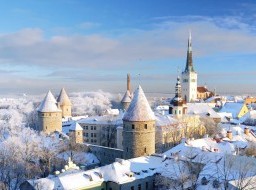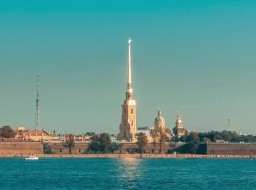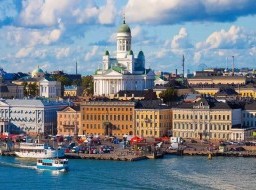Riga
‘The Paris of the North’, ‘The Second City that Never Sleeps’ – everyone’s so keen to tack on qualifying superlatives to Latvia’s capital, but regal Rīga does a hell of a job of holding its own. Riga is the fabulous capital, rich in architecture, culture and a plentiful array of attractions, Riga is by far one of the most amazing capital cities in Europe and well worth visiting. It is located on the shore of Baltic sea, on the creek of Daugava river and is the biggest city in the Baltics. Riga has given many pearls to the culture of Europe and the world – the most important include the Old Riga, Art Nouveau and wooden architecture. The heart of the city – Old Town – is a fairy-tale kingdom of winding, wobbly lanes and gingerbread trim. Riga Old Town belongs to UNESCO world Heritage. The city has the largest and most impressive showing of art-nouveau architecture in Europe. Nightmarish gargoyles and praying goddesses adorn more than 750 buildings along the stately boulevards radiating out from Riga’s castle core. Riga was built by German crusaders and early amazing buildings and fabulous churches were put up in a Romanesque and Gothic styles which German craftsmen and Cistercian monks brought from Northern Germany. By the end of the 15th century Riga had aquired a metropolitan style which was characteristic to all of the cities in the Medieval Hansiatic league. The city’s skyline of three Church steeples as it was known became a true visiting card to what was then the capital of Livonia. Riga's history is as complicated as the Latvian language, and probably has just as many influences. Its history begins in the second half of the twelfth century with the arrival of German traders, mercenaries, and missionaries. In 1158, German merchants established an outpost for trading with the Balts on the site that would become Riga, and the first monastery was built in 1190. Riga continued to function mostly as a gateway to trade with the Baltic tribes and with Russia throughout most of its history, gaining a cosmopolitan population as well as influences both from Prussia, Russia, and the Latvian population in the surrounding area. Between 1561 and 1581 Riga gained the status of a Free Imperial City, but that was short-lived as soon Riga came under the influence of the mighty Polish-Lithuanian Commonwealth. The Russo-Swedish War of 1656-1658 brought the Russians to Riga's doorsteps, but managed to keep them out until 1710, when Peter the Great invaded the city and annexed it into the Russian Empire, where it remained an industrialized port city until World War I. Throughout the many struggles and takeovers, Riga maintained its German heritage, despite the imposition of Russian in 1891 as the official language in the Baltic provinces. But the demographics were slowly changing, and Latvians began to supplant Germans as the largest ethnic group in the city in the mid-19th century. All this would change in the turbulent 20th century. World War I brought the Russian Revolution and the German Army marching to Riga. In 1918 the Treaty of Brest-Litovsk was signed, giving the Baltic countries to Germany. But because of the Armistice with Germany, Germany and Russia renounced that treaty, giving Latvia and the other Baltic States their first taste of independence. After more than 700 years of German, Swedish, and Russian rule, Latvia, with Riga as its capital city, thus declared its independence on November 18, 1918. After World War II Riga became one of the biggest centers of the western part of the Soviet Union, where according to the industrialization plans both light industry and significant enterprises of the military industrial complex were developed. Latvia declared its full de facto independence on August 21, 1991. In 2001, Riga celebrated its 800th anniversary as a city. Today, Latvia is a full-fledged member of the European Union, a huge reassurance for a country that's been occupied dozens more times than it's been independent, and Riga continues to thrive, though its German and Russian past is just as present as its Latvian future. Many call Riga - Europe’ s capital of Art Nouveau. The most distinguished street is Alberta Street, which is laid exclusively with picturesque Art Nouveau buildings designed by such master architects as Mandelstahm, Pēkšēns and Eisenstein, the latter an architect whose son went on to become the world famous film director - Sergei Eisenstein. Alberta and Strelnieku Streets comprise the biggest gallery of Art Nouveau architecture in Riga. Many buildings have still not been renovated and you can still venture into the beautiful although neglected hallways. Of particular interest are freshly renovated buildings of the Stockholm School of Economics and Law, as well as the head office of the Latvian anti-corruption police KNAB. People have occasionally called Riga little Paris while Napoleon once referred to it as a suburb of London. This may be because Napoleon never conquered London or Riga. Latvia’s capital put the torch to all of the wood buildings in its outlying areas in order to prepare for Napoleonic attack. In fact this laid the groundwork for a new phase in Rigensian architecture. The wood buildings gave way to the stone structures which form the present face of the city. Riga is an attractive and wonderful place to visit. The city’s history, architecture and people are attracting tourists from all around the world. Riga is famous for many cultural activities, including the international festival of Organ music and the festival of Ballet. An international childrens music festival attracts visitors from many countries world wide. As Germans have their October-fest and Brasilians celebrate their Great Carneval, the people of Riga and Latvia gather every June to celebrate the summer solstice festival with camp-fires, special cheese, beer and lots of singing. An unforgettable experience for anyone, the Latvian song and dance festival is staged once very four years. The main event – an open-air concert with literarry thousands of choir members performing beloved Latvian music. One specific thing you absolutely must see is Riga’s open air market place. Grown from a garage for German Zeppelins to become what was once the largest market in Europe. |






